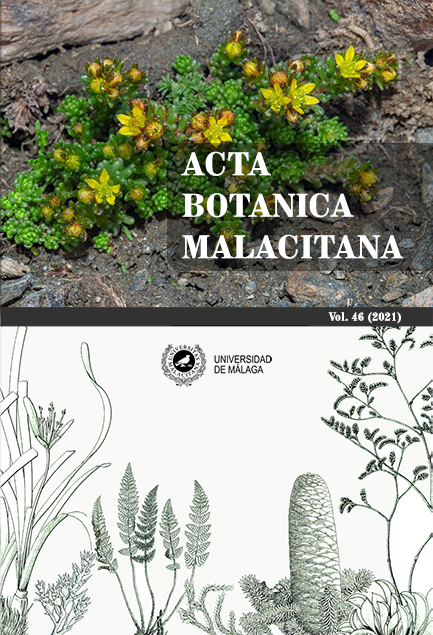New data on the Iberian plant communities of Pinguiculion longifoliae F. Casas 1970 ass. nov. (Class Adiantetea capilli-veneris Br.-Bl. in Br.-Bl., Roussine & Nègre 1952)
DOI:
https://doi.org/10.24310/abm.v46i.10790Keywords:
Pinguiculion longifoliae, Adientetea, rupiculous vegetation, nomenclature, sintaxonomy, Iberian Peninsula, AdianteteaAbstract
New data are presented on the rupicolous communities of Pinguiculion longifoliae, which occur in the Iberian Peninsula. They grow mostly on vertical, limestone or dolomitic cliffs, namely in shady rock crevices with scarcely developed soil, where tufa deposits are formed that remain sodden and dripping during most of the year due to water emergence. Although up to now the existence of five Iberian associations had been widely accepted, recent studies on the taxonomy of the rupicolous species of Pinguicula in the eastern and southern Iberian Peninsula allows a new interpretation of these fragile habitats. In this contribution, eight associations are recognised in the alliance, one of which is described as new (Eucladio verticillati-Pinguiculetum casperianae ass. nov.); a new nomenclatural combination is made at the association rank (Adianto capilli-veneris-Pinguiculetum dertosensis comb. nov.); and a nomenclatural correction is made for another one (Southbyo tophaceae-Pinguiculetum tejedensis nom. corr.). For each accepted syntaxon, data on their synonymy, usual floristic composition, ecology and chorology are provided, and their nomenclatural type is indicated (including the designation of a lectotype for Adianto-Pinguiculetum dertosensis).
Downloads
Metrics
References
Bolòs, O. de (1967). Comunidades vegetales de las comarcas próximas al litoral situadas entre los ríos Llobregat y Segura. Memorias de la Real Aca-demia de Ciencias y Artes de Barcelona, 38(1), 1-269.
Blanca, G. (2001). Pinguicula L. In J. Paiva et al. (Eds), Flora iberica, 14, 81-95. Madrid: Real Jardín Botánico, CSIC.
Blanca, G., Ruiz-Rejón, M. & Zamora, R. (1999). Taxonomic revision of the genus Pinguicula L. in the Iberian Peninsula. Folia Geobotanica, 34, 337-361. doi: https://doi.org/10.1007/BF02912819
Crespo, M.B., Alonso, M.Á., Oltra, J. & Martínez-Azorín, M. (2019a). Adianto-Pinguiculetum saetabensis (Pinguiculion longifoliae): una nueva asociación rupícola setabense. Flora Montiberica, 75, 8-10.
Crespo, M.B., Martínez-Azorín, M. & Alonso, M.Á. (2019b). Morphological and molecular data support recognition of a new rupicolous species of Pinguicula (Lentibulariaceae) from the Iberian Peninsula. Plant Biosystems, 153, 77-87. doi: https://doi.org/10.1080/11263504.2018.1461702
Crespo, M.B., Martínez-Azorín, M., Alonso, M.Á. & Sáez, L. (2020). Two new calcicolous species of Pinguicula sect. Pinguicula (Lentibulariaceae) growing on rocky habitats of the Iberian Peninsula. Phytotaxa, 456, 269-284.
Doi: https://doi.org/10.11646/phytotaxa.456.3.4
Deil, U. (1989). Adiantetea-Gesellschaften auf der Arabischen Halbinsel, Coenosyntaxa in dieser Klasse sowie allgemeine Uberlegungen zur Phylogenie von Pflanzengesellschaften. Flora, 182, 247-264. doi: https://doi.org/10.1016/S0367-2530(17)30414-0
Díaz, T.E., Guerra, J. & Nieto, J.M. (1982). Contri-bución al conocimiento de la clase Adiantetea Br.-Bl. 1942 en la Península Ibérica. Anales del Jardín Botánico de Madrid, 38(2), 497-506.
Fernández Casas, J. (1970). Notas fitosociológicas breves, I. Ars Pharmaceutica, 11, 273-298.
Fernández Casas, J. & Benito Alonso, J.L. (1999). Lectotipificación de la asociación Adianto-Pinguiculetum longifoliae Fern. Casas 1970. Lazaroa, 20, 114.
Foucault, B. de (2015). Contribution au prodrome des végétations de France: les Adiantetea capilli-veneris Braun-Blanq. ex Braun-Blanq., Roussine & Nègre 1952. Acta Botanica Gallica. Botany Letters, 162, 375-403.
https://doi.org/10.1080/12538078.2015.1108868
Gómez Mercado, F. (2011). Vegetación y flora de la Sierra de Cazorla. Guineana, 17, 1-481.
Heywood, V.H. (1954). El concepto de asociación en las comunidades rupícolas. Anales del Jardín Botánico de Madrid, 11(2), 463-481.
Mota, J. F., Gómez Mercado, F. & Valle, F. (1991). Rupicolous vegetation of the Betic ranges (south Spain). Vegetatio, 94, 101-113.
Doi: https://doi.org/10.1007/BF00032624
Pérez Latorre, A.V., Navas Fernández, D., Gavira, O., Caballero, G. & Cabezudo, B. (2004). Vegetación del Parque Natural de las Sierras de Tejeda, Almijara y Alhama (Málaga-Granada, España). Acta Botanica Malacitana, 29, 117-190.
Doi: https://doi.org/10.24310/abm.v29i0.7228
Rivas-Martínez, S. (2007). Mapa de series, geoseries y geopermaseries de vegetación de España [Memoria del Mapa de Vegetación Potencial de España. Parte 1]. Itinera Geobotanica, 17, 1-436.
Rivas-Martínez, S., Báscones, J.C., Díaz, T.E., Fernández-González, F. & Loidi, J. (1991). Vegetación del Pirineo occidental y Navarra. Itinera Geobotanica, 5, 5-456.
Rivas-Martínez, S., Fernández-González, F., Loidi, J., Lousã, M. & Penas, Á. (2001). Syntaxonomical checklist of vascular plant communities of Spain and Portugal to association level. Itinera Geo-botanica, 14, 5-341.
Rivas-Martínez, S., Díaz, T.E., Fernández-González, F., Izco, J., Loidi, J., Lousã, M. & Penas, Á. (2002). Vascular plant communities of Spain and Portugal. Addenda to the syntaxonomical checklist of 2001. Itinera Geobotanica, 15, 5-922.
Rivas-Martínez, S., Díaz, T.E., Fernández Prieto, J.A., Loidi, J. & Penas, Á. (1984). La vegetación de la alta montaña cantábrica: Los Picos de Europa. León: Ediciones Leonesas. 295 pp.
Royo, F. (2006). Flora i vegetació de les planes i serres litorals compreses entre el riu Ebro i la serra d’Irta. Tesis Doctoral. Universitat de Barcelona. 1130 pp.
https://bibdigital.rjb.csic.es/idurl/1/1526133
Sánchez Gómez, P., Gu?emes, J., Herranz, J.M., Fernández Jiménez, S., López Vélez, G. & Martínez Sánchez, J.J. (1997). Plantas vasculares endémicas, amenazadas o raras de la provincia de Albacete. Instituto de Estudios Albacetenses, Ser. I, nº 92. Albacete: Excma. Diputación de Albacete. 223 pp.
Theurillat, J.-P., Willner, W., Fernández-González, F., Bu?ltmann, H., ?arni, A., Gigante, D., Mucina, L. & Weber, H. (2020). International Code of Phytosociological Nomenclature. 4th edition. Applied Vegetation Science, 2020: e12491.
Doi: https://doi.org/10.1111/avsc.12491
Varo, J. & Fernández Casas, J. (1970). Notas sobre algunas comunidades béticas con Adiantum capillus-veneris. Ars Pharmaceutica, 11, 517-520.
Vera, J.B. (2015). Bases para la conservación de la flora protegida y hábitats prioritarios en el ámbito del sur de Albacete. Tesis Doctoral. Universidad de Murcia. 711 pp.
Downloads
Published
How to Cite
Issue
Section
License
All information related to the licensing of published works in Acta Botanica Malacitana and copyright can be found in our Editorial Policy.







1.png)
